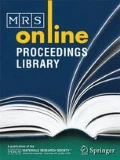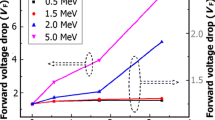Abstract
Deep level transient spectroscopy (DLTS) is the best technique for monitoring and characterizing deep levels introduced intentionally or occurring naturally in semiconductor materials and complete devices. DLTS has the advantage over all the techniques used to-date in that it fulfils almost all the requirements for a complete characterization of a deep centre and their correlation with the device properties. In particular the method can determine the activation energy of a deep level, its capture cross-section and concentration and can distinguish between traps and recombination centers.
In this invited paper we provide an overview of the extensive R & D work that has been carrier out by the authors on the identification of the recombination and compensator centers in Si and III-V compound materials for space solar cells. In addition, we present an overview of key problems that remain in the understanding of the role of the point defects and their correlation with the solar cell parameters.
Similar content being viewed by others
References
D. V. Lang, J. Appl. Phys. 45, 3023 (1974).
M. Yamaguchi, A. Khan, S. J. Taylor, K. Ando, T. Yamaguchi, S. Matsuda, and T. Aburaya, J. Appl. Phys. 86, 217 (1999).
A. Khan, M. Yamaguchi, M. Kaneiwa, T. Saga T. Abe, O. Annzawa and S. Matsuda. J. Appl. Phys. 90, 1170(2001).
A. Khan, M. Yamaguchi, M. Kaneiwa, T. Saga T. Abe, O. Annzawa and S. Matsuda. J. Appl. Phys. 87, 8389 (2000).
A. Khan, M. Yamaguchi, J.C. Bourgoin and T. Takamoto., Appl. Phys. Lett. 76, 2550 (2000).
J. C. Bourgoin and J. W. Corbett, Radiation Effects 36, 157 (1978).
L. C. Kimerling, Solid State Electronics, 21, 1391 (1978).
L. C. Kimerling and D. V. Lang, Inst. Phys.Conf. Ser. 23, 589 (1975).
J. C. Bourgoin and J. W. Corbett, Phys. Lett. 83A, 135 (1972).
J. C. Bourgoin and J. W. Corbett, Inst. Phys. Conf. Ser. 23, 149 (1975).
D. V. Lang and L. C. Kimerling, Phys. Rev. Lett. 35, 22 (1975).
A. Khan, Masafumi Yamaguchi, Jacques C. Bourgoin, and Tatsuya Takamoto. J. Appl. Phys. 89, 4263 (2001).
A. Khan, S. Marupaduga , M. Alam, N. J. Ekins-Daukes, Appl. Phys. Lett. 85, 5218 (2004).
Author information
Authors and Affiliations
Rights and permissions
About this article
Cite this article
Khan, A., Yamaguchi, M. DLTS: A Promising Technique for Understanding the Physics and Engineering of the Point Defects in Si and III-V Alloys. MRS Online Proceedings Library 994, 09940705 (2006). https://doi.org/10.1557/PROC-0994-F07-05
Received:
Accepted:
Published:
DOI: https://doi.org/10.1557/PROC-0994-F07-05




